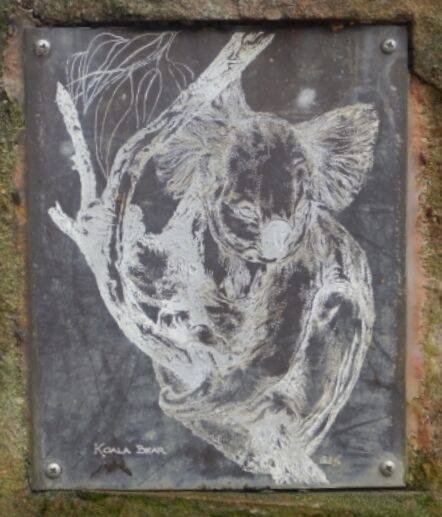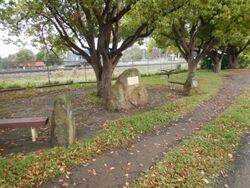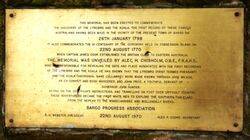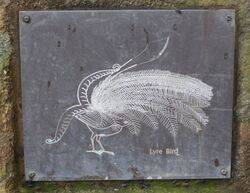
First Recorded Sighting of Lyrebird & KoalaPrint Page 
The plaque commemorates the first recorded sighting by Europeans of the lyrebird and koala in the vicinity of Bargo on the 26th January 1798.
The plaque is mounted on one of three rough hewn boulders and also commemorates the bicentenary of the ceremony held on Possession Island by Captan Cook on the 22nd August 1770. The flanking boulders each carry depictions of a lyrebird and koala.
The first European sighting of the koala and lyrebird are said to have occurred in the area in 1798. John Price, a servant of Governor Hunter, recorded the two in his diary while a member of an exploratory party investigating the land south-west of Parramatta. The trek`s objective was to accumulate data about the southlands to discourage convicts from escaping south in the belief that China was only 150 miles away. Price described the lyrebird as a pheasant, hence the name of the nearby village of Pheasants Nest, and he noted that the koala was known as Cullawine by the local Aborigines.
Location
| Address: | Railside Avenue (Remembrance Drive), Park near Railway Station, Bargo, 2574 |
|---|---|
| State: | NSW |
| Area: | AUS |
| GPS Coordinates: | Lat: -34.290376 Long: 150.579663 Note: GPS Coordinates are approximate. |
Details
| Monument Type: | Monument |
|---|---|
| Monument Theme: | Culture |
| Sub-Theme: | Animals |
| Actual Event Start Date: | 26-January-1798 |
| Actual Event End Date: | 26-January-1798 |
Dedication
| Actual Monument Dedication Date: | Saturday 22nd August, 1970 |
|---|
This memorial has been erected to commemorate the discovery of the Lyrebird and the Koala. The first record of these famous Australians having been made in the vicinity of the present town of Bargo on 26th January 1798
It also commemorates the bi-centenary of the ceremeny held on Possession Island on 22nd August 1770 when Captain James Cook established the British claim to Eastern Australia.
The memorial was unveiled by Alec H. Chisholm, O. B. E., F. R. A. H. S., who was responsible for revealing the date and place associated with the first recording of the Lyrebird and the Koala. He has shown that the Lyrebird (first termed Pheasant) and the Koala (Aboriginal name Cullawne) wre made known thrrough John Wilson, an ex-convict and bush wanderer, and John Price, a youthful servant of Governor John Hunter.
Acting on the Governor`s instructions, and travelling on foot over difficult country, these adventurers became the first white men to explore the Southern Tableland form the Nepean to the Wingecarribee and Wollondilly Rivers.
Bargo Progress Assocation
R. H. Webster, President. 22nd August 1970 Alex P. Cooke, Secretary








